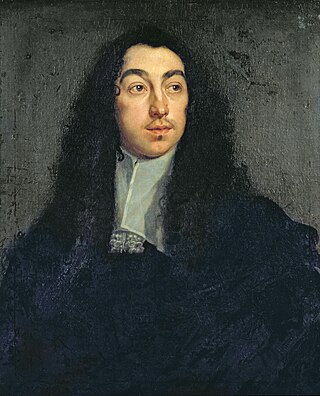
John Ogilby was a Scottish translator, impresario and cartographer. Best known for publishing the first detailed British road atlas, he was also a successful translator, noted for publishing his work in handsome illustrated editions. He also established Ireland's first theatre on Dublin's Werburgh Street.

Sir William Davenant, also spelled D'Avenant, was an English poet and playwright. Along with Thomas Killigrew, Davenant was one of the rare figures in English Renaissance theatre whose career spanned both the Caroline and Restoration eras and who was active both before and after the English Civil War and during the Interregnum.

James Shirley was an English dramatist.
This article contains information about the literary events and publications of 1653.
This article contains information about the literary events and publications of 1613.

Richard Brome ; was an English dramatist of the Caroline era.

Matthew Locke was an English Baroque composer and music theorist.
Humphrey Moseley was a prominent London publisher and bookseller in the middle seventeenth century.
The Coronation is a Caroline era stage play, a tragicomedy written by James Shirley, and notable for the tug-of-war of authorship claims in which it was involved in the middle seventeenth century.
The Sisters is a Caroline stage play, a comedy written by James Shirley. It was the last of Shirley's plays performed in London prior to the closing of the theatres in September 1642, at the start of the English Civil War. "Slight in substance, The Sisters is excellent in matter of technique, and especially in...structural unity...."
Love Freed from Ignorance and Folly was a Jacobean era masque, written by Ben Jonson and designed by Inigo Jones, with music by Alfonso Ferrabosco. It was performed on 3 February 1611 at Whitehall Palace, and published in 1616.
A Contention for Honor and Riches is a Caroline era stage play, a short drama or interlude written by James Shirley and first published in 1633. Generally classed as a morality play, it illustrates the continuing influence of archaic forms of drama on the relatively "sophisticated" or even "decadent" theatre of the Caroline era.
The Triumph of Beauty is a Caroline era masque, written by James Shirley and first published in 1646. The masque shows a strong influence of Shakespeare's A Midsummer Night's Dream.
The Masque of the Inner Temple and Gray's Inn, also known as, The Masque of the Olympic Knights, is an English masque created in the Jacobean period. It was written by Francis Beaumont and is known to have been performed on 20 February 1613 in the Banqueting House at Whitehall Palace, as part of the elaborate wedding festivities surrounding the marriage of Princess Elizabeth, the daughter of King James I, to Frederick V, Elector Palatine.
The Court Secret is a Caroline era stage play, a tragicomedy written by James Shirley, and first published in 1653. It is generally regarded as the final play Shirley wrote as a professional dramatist.
Andromana, or The Merchant's Wife is a mid-seventeenth-century stage play, a tragedy first published in 1660. It has attracted scholarly attention for the questions of its authorship and the influence of its sources.
Andrew Crooke and William Cooke were London publishers of the mid-17th-century. In partnership and individually, they issued significant texts of English Renaissance drama, most notably of the plays of James Shirley.
The Lady Mother is a Caroline era stage play, a tragicomedy generally attributed to Henry Glapthorne, and dating from the middle 1630s. Never printed in its own era, the play survived in a manuscript marked as a theatre prompt-book, revealing significant details about the stage practice of its time.
Thomas Dring was a London publisher and bookseller of the middle seventeenth century. He was in business from 1649 on; his shop was located "at the sign of the George in Fleet Street, near St. Dunstan's Church."
The Cruelty of the Spaniards in Peru was an innovative 1658 theatrical presentation, a hybrid entertainment or masque or "operatic show", written and produced by Sir William Davenant. The music was composed by Matthew Locke.